South Africa: 59 people murdered on farms in 2020/21 - AfriForum
Farm murders on the increase again
12 May 2021
The civil rights organisation AfriForum today released its latest statistics regarding farm attacks. Since April last year, there have been 395 farm attacks countrywide.
Although there was a decline in the number of farm attacks in the 2020/2021 financial year compared to the previous financial year, there was an increase in farm murders. During the past year, 59 people were murdered on farms in South Africa, compared to 41 in the previous year.
Farm attacks continue to be a source of grave concern because of the excessive violence that regularly is used during these crimes. In 22% of the attacks, victims were brutally tortured by burning them with irons, by battering or kicking them to death or by repeatedly stabbing them with a sharp object.
64% of victims were over the age of 50.
Items that were plundered most often during farm attacks are firearms, vehicles and electronic appliances, although in at least six farm murders nothing was stolen.
“The fact that farm murders and the brutality of the attacks have increased despite a decrease in the number of attacks is extremely worrying. It also shows that the lip service the Minister of Police and the President paid to the matter for a short while last year in fact has not yielded any results and that it is becoming increasingly important for communities to look after their own safety,” says Ernst Roets, AfriForum’s Head of Policy and Action.
AfriForum encourages rural residents to take their safety in their own hands, within the framework of the law, and to establish safety networks or to join one of AfriForum’s 160 neighbourhood and farm watches countrywide.
The organisation recently also launched its Safeguard a Farm campaign. For more information about the campaign, please visit www.beveilignplaas.co.za.
Ernst Roets
Head: Policy and Action
AfriForum
Andrea Muller
Researcher
AfriForum
Text of report:
FARM MURDERS in SOUTH AFRICA
2020/2021 financial year
Introduction
One of the core responsibilities of the South African Police Service (SAPS) – that is stated in Chapter 11 of the Constitution of the Republic of South Africa – is to “prevent and to investigate any crimes that threaten the safety or security of any community”. 1
Although this is the responsibility of the SAPS, Minister Cele Bheki’s refusal to classify farm murders and farm attack as a priority crime, the SAPS cannot fully uphold its constitutional duties.
On 5 February 2021, the charred bodies of an elderly couple were discovered in Gauteng. The couple was tortured outside of their house; hair, nails and blood found at the scene provided proof of this horrendous event. The couple was then dragged inside their house. It is believed that the couple was shot before the house was set on fire, but not before they were tied up on the floor next to each other. A Bible was placed between the couple; thereafter a heater was switched on with curtains placed on top of it.
Unfortunately, murders like these are not isolated incidents.
A definition of farm attacks
The definition for farm attacks used by AfriForum Research for this report is the definition published in the National Rural Safety Strategy:2
…[a]cts of violence against person(s) living in rural areas, including farms and smallholdings, refer to acts aimed at person(s) residing in, working in, or visiting rural areas, whether with the intent to murder, rape, rob or inflict bodily harm. In addition, all acts of violence against the infrastructure and property in the rural community, which are aimed at disrupting farming activities or other commercial concerns, whether the motive(s) are related to the commission of other crime(s), ideology, land disputes, land issues, revenge, grievances, racist concerns or intimidation are included in this definition.
The definition excludes cases that relate to domestic violence or alcohol abuse, or cases that resulted from commonplace social interaction between people or any labour disputes.
Statistical analysis of data
The integrity, data collection and verification process is of the utmost importance. The data used in this report was thoroughly verified and the information was collected from various reliable sources, including media outlets, different security networks, social media and – in some cases – directly from the families affected.
It is important to note that the farm murder statistics that are used in this report are subject to change. This is because information sometimes only becomes available long after the incident had occurred, or because of insufficient or conflicting information regarding a case.
This report will focus mainly on the farm murders that were committed during the 2020/2021 financial year (from April 2020 to March 2021).
The statistics
Farm attacks
There were 395 confirmed farm attacks during the period under review. This is down from 465 attacks that were recorded for 2019/2020. Most of the attacks occurred in August 2020, with the least murders committed in April 2020. It must be noted that these numbers are subject to change and may not necessarily be a true reflection of all attacks that occurred because the media or different networks do not always report on every single attack.
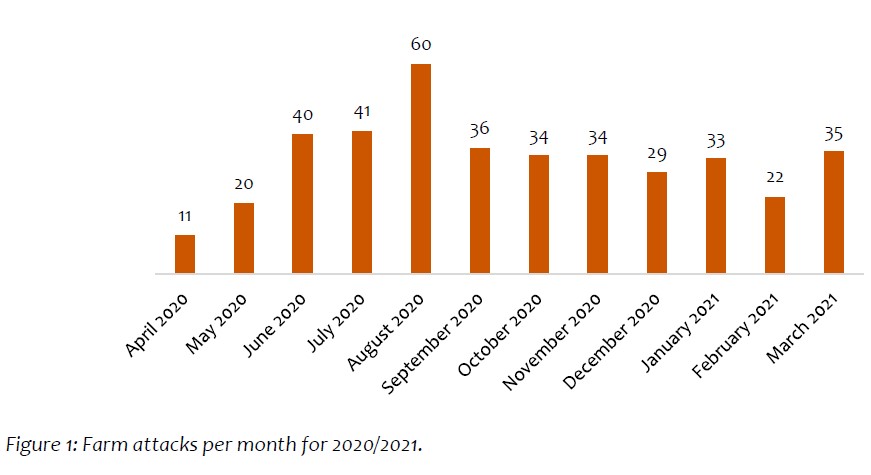
Farm murders
AfriForum recorded 59 confirmed farm murders during the period under review, a notable increase from 41 murders for the 2019/2020 financial year.
There seems to be a trend in the most recent years, where farm attacks are decreasing, but farm murders are increasing. This may be because many attacks are prevented by different security networks; however, in cases where the attack do take place, it takes a more violent turn.
Murders per month
Most recorded murders occurred in December 2020, followed by July and August 2020. April 2020 and January 2021 saw the least number of murders, as shown in figure 2.
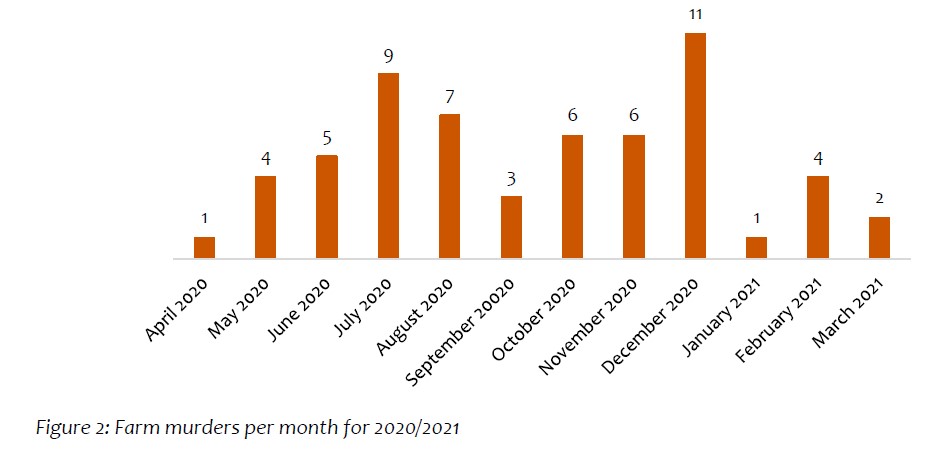
Murders per province
Most farm murders were committed in KwaZulu-Natal and Gauteng, followed by the Free State and Mpumalanga. No farm murders were recorded in the North West. The increase in not only general crime in KwaZulu-Natal, but also in farm murders is concerning. During the 2019/2020 financial year, farm murders in KwaZulu-Natal only accounted for 7% of total incidents, with 3 murders. This extreme increase in murders in the province must be researched and addressed.
Table 1: Farm murders per province
Province | Murders | Percentage |
KwaZulu-Natal | 15 | 25% |
Gauteng | 14 | 24% |
Free State | 9 | 15% |
Mpumalanga | 9 | 15% |
Eastern Cape | 4 | 7% |
Limpopo | 3 | 5% |
Northern Cape | 3 | 5% |
Western Cape | 2 | 3% |
North West | 0 | 0% |
Time of occurrence
Day of the week
Most murders were committed on Mondays and Saturdays, whereas the least were committed on Wednesdays.
The day on which the attack takes place is influenced by the motive of the crime – whether the attacks were pre-mediated or opportunity-driven also influences the day and the time of the attack.
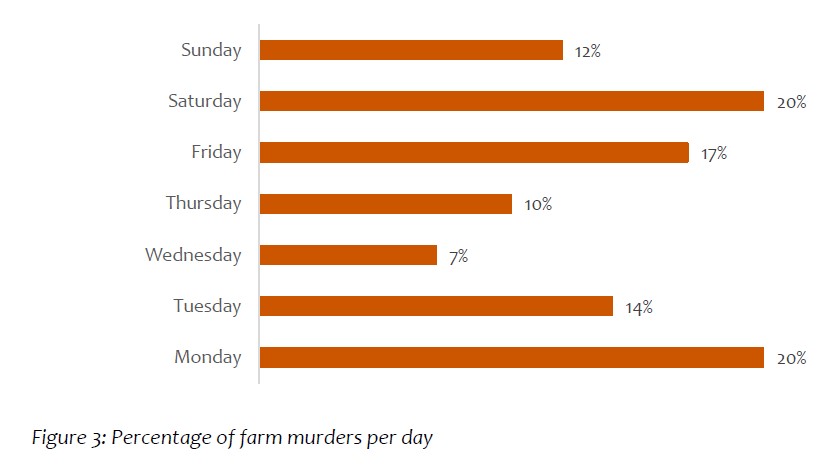
Time of day
Most farm murders were committed between 18:00 and 03:00. 3 This is the time slot in which victims are their most vulnerable – most likely taking a break after a day’s work or asleep – and are caught off guard. Victims have little to no time to protect/defend themselves from the attack, seeing as the offenders use the element of surprise to their advantage.
Table 2: Percentage of farm murders per time interval
Time | Percentage |
00:00–03:00 | 12% |
03:01–06:00 | 3% |
06:01–09:00 | 2% |
09:01–12:00 | 2% |
12:01–15:00 | 2% |
15:01–18:00 | 5% |
18:01–21:00 | 19% |
21:01–24:00 | 15% |
Unknown | 40% |
Farm vs. smallholding
The majority of the murders took place on a farm, as per the definition.
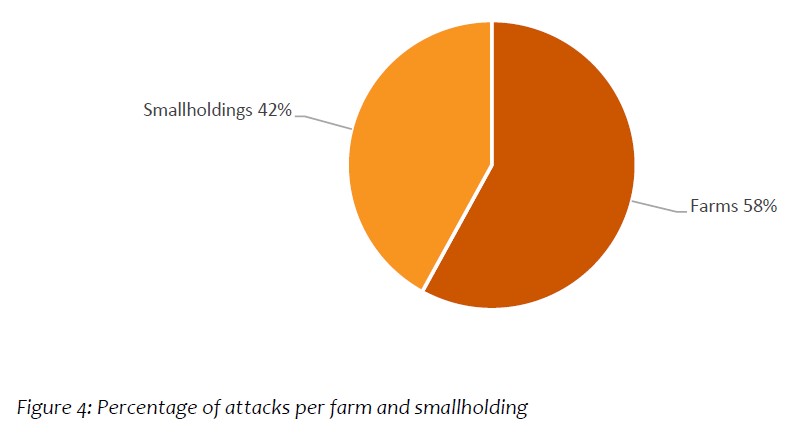
Victims
In some of the attacks, not all the victims are murdered, but they are still affected. When we consider farm murders specifically, 100 people were the victims of farm attacks, while 59 of those murdered.4
Occupation
The majority of murder victims were farm owners or farmers on the property. In one case, the occupation of the murder victim remains unknown.
Table 3: Occupation of victims
Occupation of victim | Percentage of murders |
Owner/farmer | 59% |
Unpaid family | 16% |
Visitor | 10% |
Farm worker | 8% |
Foreman | 5% |
Unknown | 2% |
Ages5
The most vulnerable victims were between 60 and 69 years old, whereas the majority of victims (64%) are older than 50 years. These age groups will most likely fail to defend themselves, and they are murdered.
This highly targeted group of victims often also has to endure abuse. Even though they are little to no threat to attackers, they are still tortured and brutally killed.
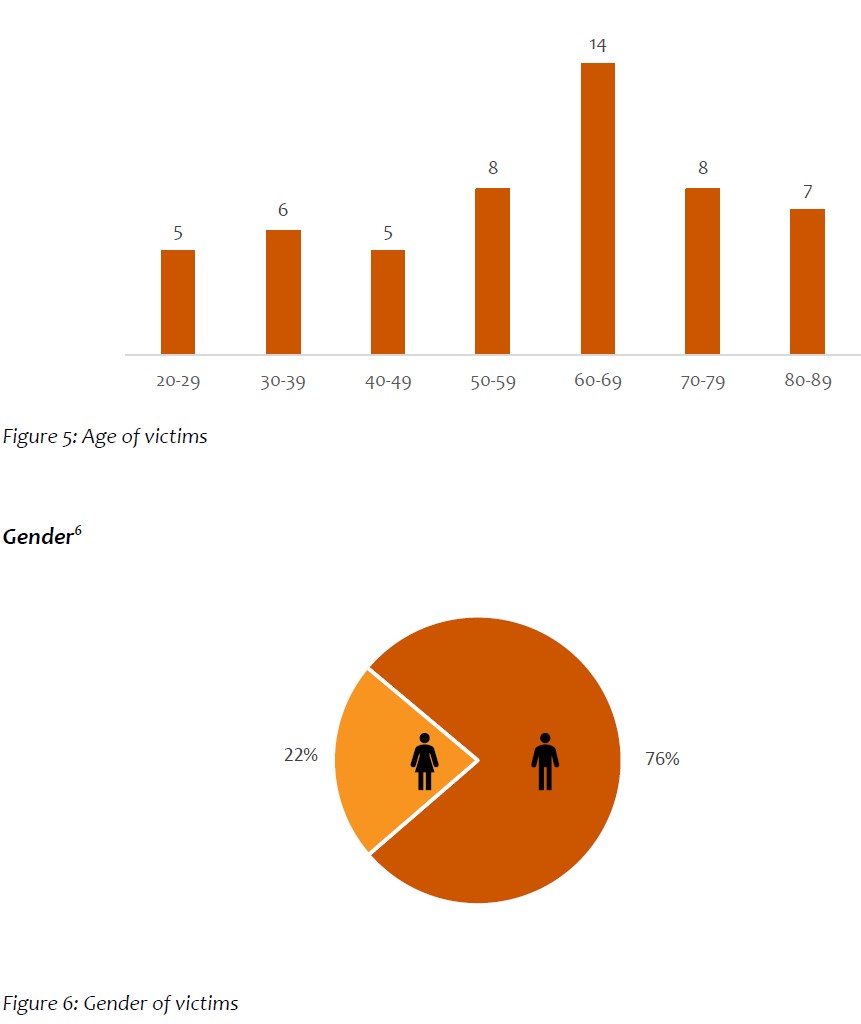
Attackers
Attackers most commonly operate in groups of two to five people. In many cases, more people are involved in the attack, but not every attacker is identified or seen by the victims during the attack.
TORTURE
At least one form of torture was inflicted on victims in 22% of the incidents. Methods of torture include burning victims, beating victims to death, stabbing them multiple times or strangling them.7
WEAPONS USED
The most commonly used weapons in these attacks are firearms, knives or any blunt object available to the attacker.
In many cases, the victim was killed without any tools and was therefore beaten or even kicked to death. In cases where the victim was tied up, household items were used to do so, such as cell phone chargers, wires or shoelaces.
STOLEN ITEMS
The most common items stolen from the scene include vehicles, cell phones, and household electronics such as laptops and televisions. Firearms (pistols, shotguns and rifles) are some of the most stolen items.
In six incidents, nothing was stolen from the murder scene.8
Conclusion
It is not just the farming community that is affected by these crimes – and the responsibility of protecting themselves should not solely rest on their shoulders.
The question remains: How many more victims must go through these traumatic events before the government decides that this is serious enough to warrant a sustainable, effective plan? How many more citizens have to be tortured, killed, and traumatised before this is seen as serious?
When farm attacks and farm murders are classified as priority crimes, more in-depth scientific research can be conducted on this crime phenomenon. This will lead to more effective counter- strategies and prevention methods, although sufficient resources will have to be provided to implement these successfully.
This will go a long way in preventing these crimes and successfully prosecuting offenders according to their crimes’ brutality.
Footnotes:
1 See https://www.saps.gov.za/about/about.php.
2 South African Police Service. 2019. The National Rural Safety Strategy. Available at https://www.saps.gov.za/resource_centre/publications/national_rural_safety_strategy_2019.pdf. Accessed on 4 May 2021.
3 The exact time for 40% of incidents remains unknown.
4 In two cases, the number of victims is unknown.
5 The age of six victims is unknown.
6 In one case (2%), the gender of the victim remains unknown
7 In 14% of the incidents it is not known whether the victims were tortured.
8 In 18 cases it is unknown what items were stolen (if any).
ENDS
Issued by AfriForum, 13 May 2021
https://www.politicsweb.co.za/documents/59-people-murdered-on-farms-in-202021--afriforum

No comments:
Post a Comment